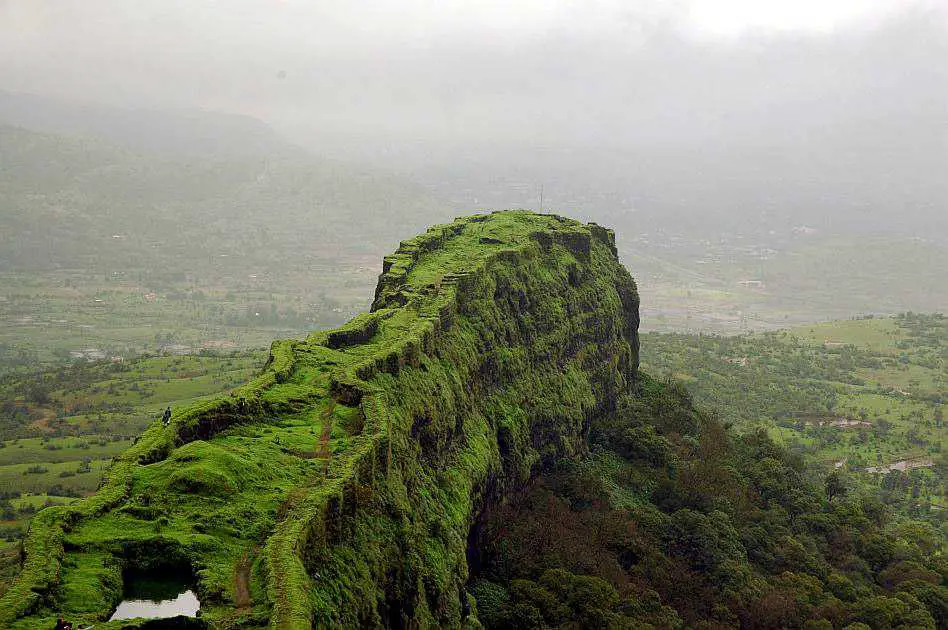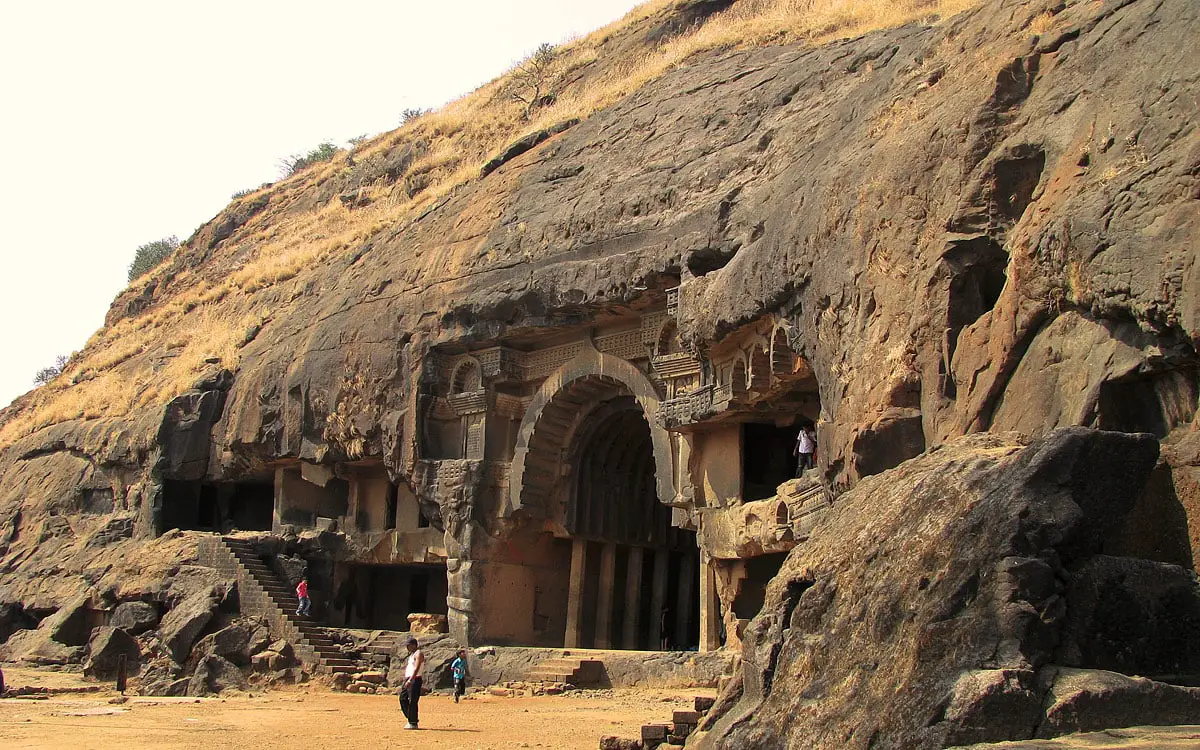World 🢖 Asia 🢖 India 🢖 Maharashtra
Fortresses and forts 🢔 Fortifications 🢔 Architectural wonders 🢔 Categories of wonders
Wonder
Ankai-Tankai hill forts
 In short
In short
There is not too much known about the early history of the impressive twin forts – Ankai-Tankai hill forts.
 41.8%
41.8%
GPS coordinates
Location, address
Alternate writing
Writing in Marathi
Age
Map of the site
If you see this after your page is loaded completely, leafletJS files are missing.
 In detail
In detail
Nowadays both wonderful table-top mountains serve as extraordinary destinations for weekend trips but just a few centuries ago there happened wild battles to conquer these windswept plateaus – once upon a time some of the best-protected forts in this part of India.
Land of hill forts
Satmala Range (former Chandor Range, also Chandwand Range) south from Manmad is a range of table-top mountains running from west to east. This range contains many impressive and beautiful ancient hill forts.
Two impressive table-top mountains of this range – Ankai and Tankai – rise up to 275 m high above the surrounding landscape. The highest summit is located on Ankai – 961 m above sea level and here opens a wide view of the valleys of Khandesh and Godavari. Both hills from all sides have nearly vertical walls with several steps and only the narrow saddle between both hills makes them ascendable.
Ankai is located more to the west. The uneven plateau on its top is up to 700 m long and approximately 200 m wide. The eastern side of the plateau contains a steep hill which is rising some 45 m above the other plateau.
Tankai is located to the east and is somewhat larger. It is up to 800 m long and up to 600 m wide. The surface of Tankai is more flat, windswept.
At the base of Tankai there are located several 700 – 10000 years old Jain rock-cut temples, some more Hindu rock-cut temples are on Ankai – see description at Ankai-Tankai Caves.
Both hillforts nowadays are easy to ascend. Most tourists ascend from the Kusur (Ankai) village to the south from the saddle between both hills. First, they pass by the Tankai Jain Cave Temples and through arched entrance door then reach the saddle and have a choice to ascend either Tankai or Ankai via a path of stone-cut steps.
For the most part of the year the area is grey and desert-like but during the monsoon miraculous change happens – even the plateaus on top of both hills are covered with lush green grass with some low shrubs in some places.
Ankai hill fort
While ascending Ankai fort one should pass through 7 rings of fortifications, passing by one Hindu rock-cut temple. The winding steps leading towards the top of the hill were easy to defend. Especially hard for the enemy was the final ascent – some 60 – 70 stone steps were broad enough just for one man and few defenders could easily fight off even with the help of stones. One more way to protect the hillfort was firewood kept at the gateways – in a case of attack fire was set and the further attack was impossible.
Behind the last gateway there stand remnants of a curious domed building – it is said that in earlier times this was a treasure chamber.
Top of the hill earlier had many buildings, nowadays only ruins of some remain. Plateau contains up to 15 m deep rock-cut granaries, 7 water tanks. The most impressive ruins are located in the far western end – this is a former palace with a huge pond in front of it. At the base of the hill on the eastern side of the plateau, there are located Hindu rock-cut shrines with hermits living here up to this day.
In the middle part of Ankai there is a square water tank with an ancient sculpture in the middle.
Tankai hill fort
Ascent to the plateau of Tankai hill also leads through a fortified wall with an arched door.
Plateau on the top of Tankai is flatter and lower than the top of Ankai. The grass-covered plateau is windy, nowadays it is used for horse grazing. Here is no shelter, though the plateau contains a semi-collapsed Shiva temple built of large stone blocks adorned with stone carving and ox Nandu sitting in the front of the building and looking towards the shrine of Shiva.
All four corners of the plateau have traces of former fortifications, on the eastern side are located remnants of a well-built guardhouse.
Most likely Tankai served as a huge storage facility of supplies for Ankai fort.
Known history
In 1635 both forts were captured by the general Khan Khanan of the great Mughal Emperor Shah Jahan – the builder of Taj Mahal.
Nowadays both hills serve as wonderful tourist destinations – but tourists are required to respect this wonderful monument of past.
The last time when forts were captured was on April 5, 1818, when Brits (unit of Lieutenant-Colonel McDowell) took them without bloodshed. This was great luck for Brits as the fort had a large amount of ammunition and neighboring forts were ready to take up a rebellion if Ankai would start it.
Forts were dismantled in 1827 – only in Ankai there was left garrison for some longer time.
References
- Ankai Tankai, Nashik District Gazetteer, accessed in 5 May 2010.
- Ankai-Tankai-Gorakshanath, a photoblog by Rohan Rao, accessed in 5 May 2010.
 Linked articles
Linked articles

Wonders of Maharashtra
Maharashtra is a truly splendid state. It has everything – enormous metropolises and countless waterfalls in mountains, urban decay, and architectural splendor, remnants of millennia-old Harappan towns, and modern, very expensive architecture.

Rock-cut architecture and sculptures
Rock-cut architecture is a very ancient form of architecture – the oldest structures are more than 5 thousand years old. The resistivity of the natural stone and the constant climate inside these structures has preserved many art values around the world.

Wonders of India
India is the seventh-largest country in the world by area, and, naturally, such a large area contains a huge amount of exciting attractions…
Wondermondo considers that India is the second richest center of architectural heritage in the world after Europe and maybe no single country in the world can match it in this respect.
 Recommended books
Recommended books
50 things to do in Pune
Pune is the second-largest city in the Indian state of Maharashtra and the 9th most populated city in India as well. Now amongst the major metropolitan cities in India, historically it represented the center of power of the Maratha Empire established by Shivaji Maharaj. Several forts and other evidence of this magnificent history can still be found in and around Pune, and many of them are definitely worth more than just a visit.
Mighty Maharajas: Forts & Palaces of India
The Indian subcontinent offers a fascinating collection of historic forts and royal palaces waiting to be explored. Over the centuries, as kingdoms rose and fell or expanded into mighty empires, the need for protection against invaders resulted in the building of magnificent forts and fortified citadels across the country.


